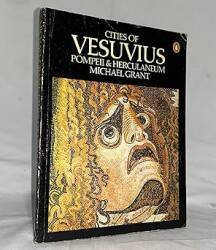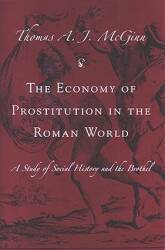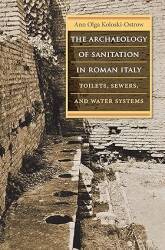
The Toilets and Related Infrastructure of Roman Pompeii
Pompeii and Vesuvius
Pompeii was founded around the 7th to 6th century BC by the Oscans (or Osci) of central Italy, on an important crossroad between Cumae, Nola, and Stabiae. Unfortunately, the city also happened to be very close to a powerful volcano. The city was built on a spur of land that had been formed by a lava flow. The lower archaeological layers are jumbled, suggesting large landslides that had failed to drive the settlers to a safer location.
There was a devastating earthquake in 63 AD, but the inhabitants rapidly rebuilt the city. The population had grown to around 20,000.
Then, over the two days of 24-25 August 79 AD, the city was buried by a catastrophic eruption of Mount Vesuvius. About 10% of the population was killed as the city was buried under up to twenty meters of ash and pumice.

Mount Vesuvius as seen from the Forum in Pompeii.
Pompeii
I first visited Pompeii in 2009, and then I returned in 2025. These pictures and observations are from both of those trips. Some areas were closed or even still buried on my first visit, then I could see them on the second visit. Some were the other way around, open in 2009 but closed in 2025.
The Greek author and scientist Pliny the Elder had been appointed præfect of the Roman Navy.
He wanted to rescue some friends and closely observe the fascinating volcanic phenomenon. Unfortunately, that led to his death. The account by his nephew Pliny the Younger of the eruption and his uncle's death is famous. See letter VI:XVI To Tacitus, Letter 16 from the Sixth Book of Letters of Pliny the Younger. He described an enormous eruption column. A pyroclastic flow, or cloud of superheated gas, ash, and rock, rushed down the flanks of Vesuvius and covered the surrounding area. Modern analysis suggests an ash cloud temperature of 850°C at the point of eruption cooling to 240 to 350°C by the time it reached the city.
The city was known to history but physically lost. An architect digging a new course for the river Sarno rediscovered the site in 1592, but there was no serious excavation until 1748. Giuseppe Fiorelli, who took charge of excavations in 1860, realized that voids in the ash layers containing human remains were spaces left by decomposed bodies. He came up with the technique of injecting plaster into these voids to recreate the victims. It soon became a popular spot on the "Grand Tour" of Europe.
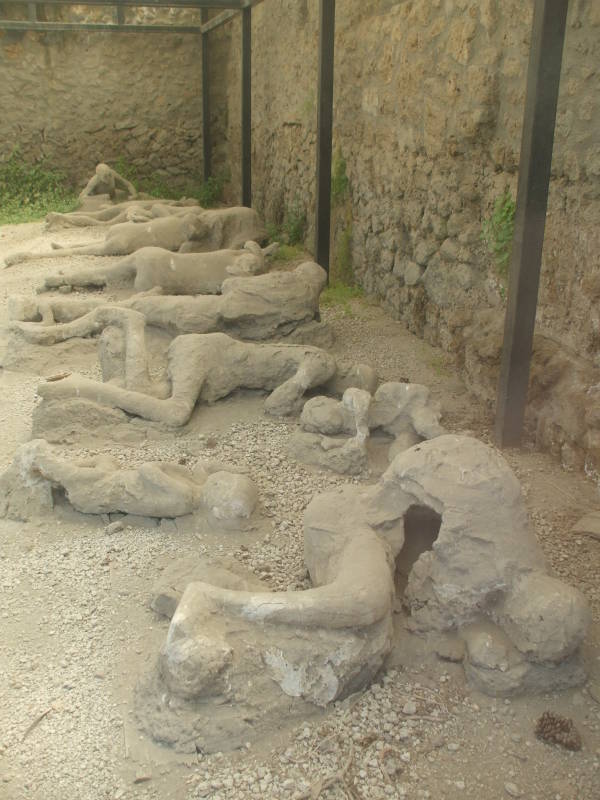
Plaster casts of victims.
Pompeii is a large and very popular site — about 66 hectares and about 3.5 million visitors annually.
Roman Brothel Toilet
The Lupanaro is the famous well-preserved brothel in Pompeii, the name referring to the home of the "she-wolves". It's about two streets northeast of the north end of the Forum, along Vicolo Stortlo.
The exterior of the two-story brothel and its toilet are seen below.
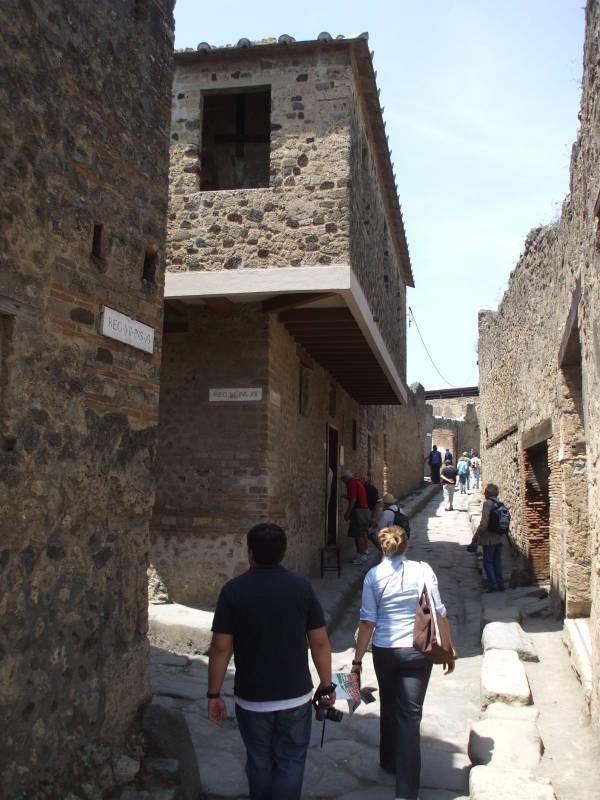
The Lupanaro, the famous brothel of Pompeii.
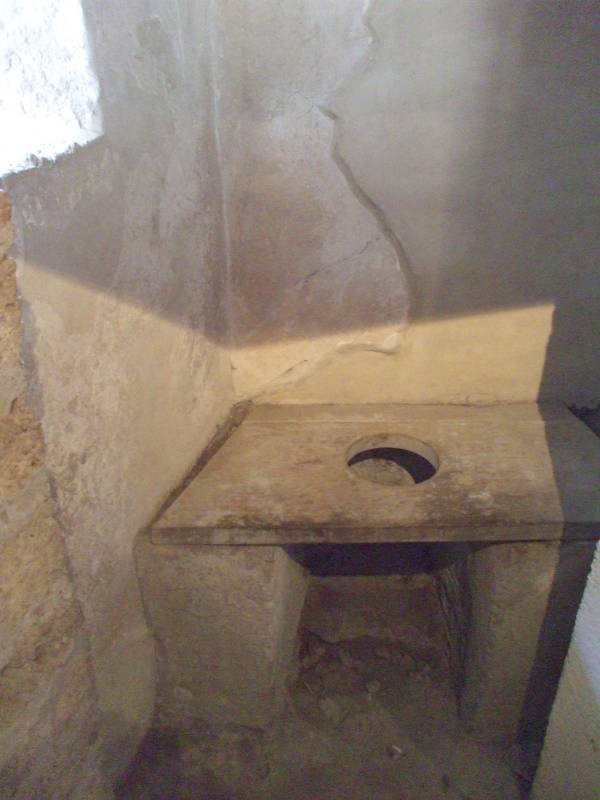
A Roman brothel toilet.
It's a pretty basic one-hole frame design. A chamber pot would be placed below the hole, and then taken out and emptied into the sewer immediately outside. So, it's an indoor toilet, but not indoor plumbing.
Europeans didn't have toilet paper until recently. The Romans, at least the higher classes, used a tersorium, also called a xylospongium, a sponge mounted on a stick. The sponge could be dipped into a water channel running in front of the row of communal toilets in the latrine, and rinsed off in that channel after use. If there was no channel of running water, a bucket of salt water or vinegar water would be used, as Seneca described in his Letters of Lucillus [70,20].
If neither a tersorium nor water were available, the Greeks and Romans used πεσσοι or pessoi, small stones, to clean themselves. The tradition started with the ancient Greeks that three stones should be enough to finish the job. This convention has been very long lived, with a hādīth attributed to Muhammad specifying three stones as the ideal number for anal cleaning. The pessoi were also used in an ancient board game in Greece. Aristophanes wrote a scene involving pessoi in Peace in the 5th century BCE. Here's the Penguin Classics translation:
Arms dealer [displaying a cuirass]: And what, alack, shall I do with this rounded cuirass, a beautiful fit, worth ten minas?
Trygaeus: Well, that one will not make a loss for you, anyway. Give me that at cost price. It will be very convenient to crap in ...
Arms dealer: Stop this impudent mockery of my goods!
Trygaeus [placing the cuirass on the ground like a chamber pot and squatting on it]: Like this, if you put three stones beside it. Is it not clever?
The Greeks would use όστρακα or ostraka, small pieces of broken ceramic goods, to vote to shun or ban their opponents. This is where we get the word ostracize. Some scholars have suggested that the ostraka could be used as pessoi, literally wiping your feces onto the names of hated individuals. The abrasive characteristics of broken ceramic material suggest that long-term used of these as pessoi could have resulted in localized irritation at the least, progressing to skin or mucosal damage or the irritation of external hemorrhoids. For more on toilet use of pessoi and ostraka and the medical implications see the paper "Toilet hygiene in the classical era", Philippe Charlier, Luc Brun, Clarisse Prêtre, and Isabelle Huynh-Charlier, in BMJ (the British Medical Journal) 2012, pages 345-346.
Most brothels in Pompeii were single-room operations. The Lupanaro was the largest, with ten rooms. The beds look awfully uncomfortable, as all that survives today is the solid stone bed form and "pillow". There would of course have been mattresses and pillows on top of this!
The book "Cities of Vesuvius: Pompeii and Herculaneum" (Michael Grant, Phoenix Press, 1971) quotes the earlier "Present State of Pompeii", by Malcolm Lowry, 1949: "The brothels were by no means spacious and 'seemed to have been made to accommodate the consummations of some race of voluptuous dwarfs'." In other words, the beds are rather short.
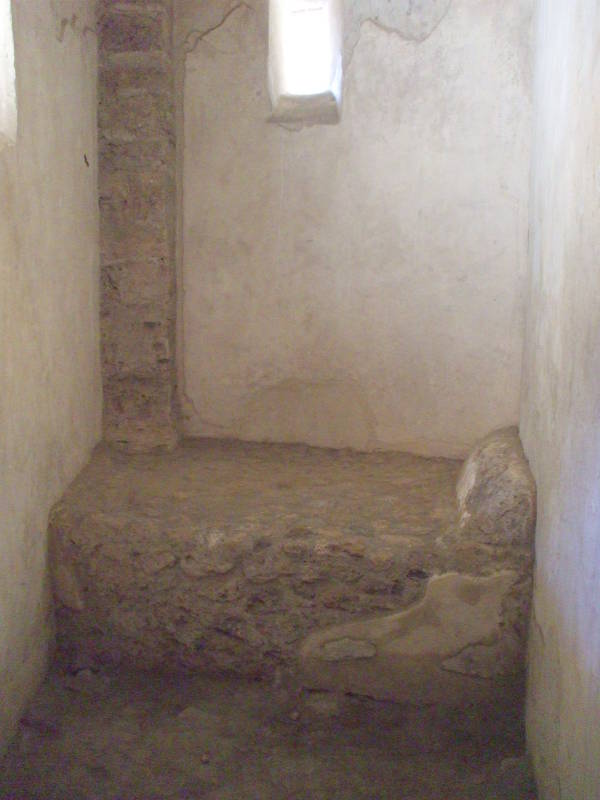
A stone bed in the brothel.
The frescos are the brothel's feature of greatest interest to most historians outside the specialty of toilet history. It seems to me that the frescos may have served as more than simple decoration. Perhaps they were a graphical menu of available choices. "I'll have Number 3, please."
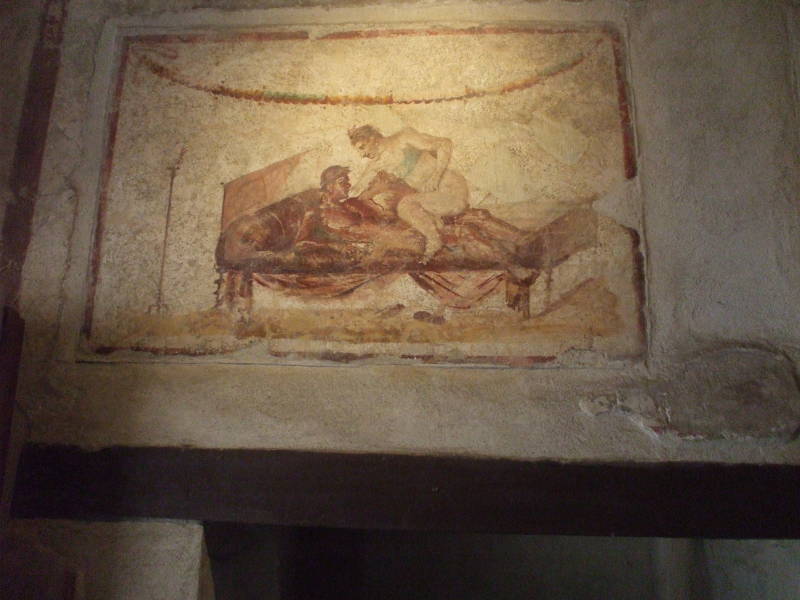
All of the erotic and fertility related imagery shocked the excavators and early influential visitors. Some discoveries seem to have been re-buried and then re-discovered in later years. A large collection at the National Archaeological Museum in Naples was inaccessible without academic credentials or special permission until 2000.
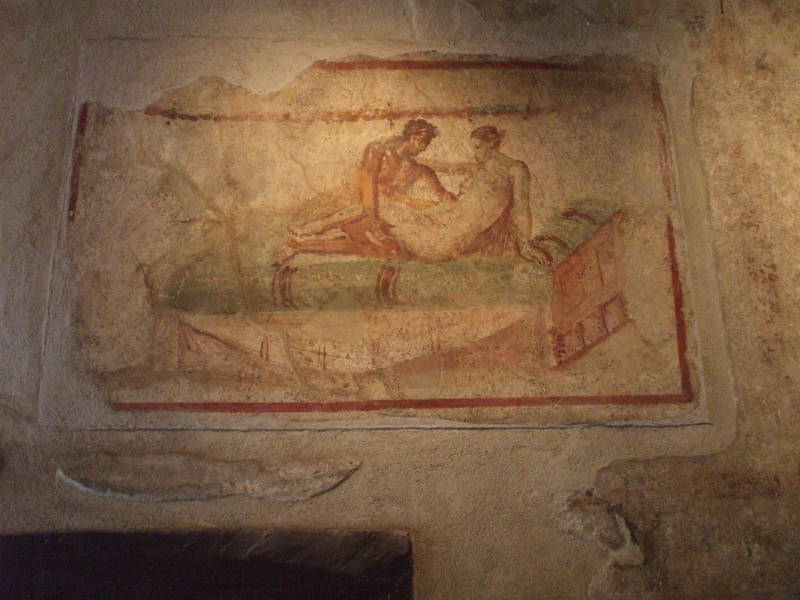
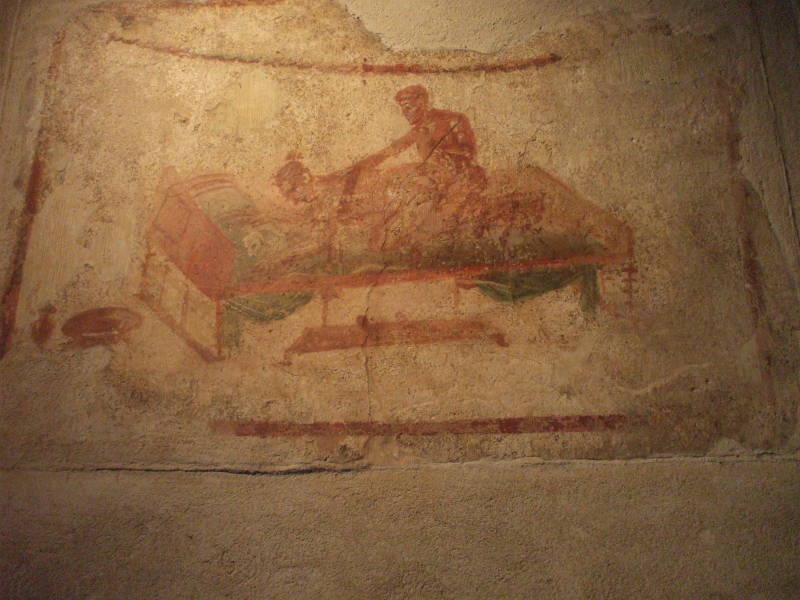
Graffiti on the walls of the Lupanaro indicates that the prostitutes were slaves from all around the Mediterranean. The frescos themselves show that there's nothing new in the way of stereotypes. They intentionally depict the women with significantly lighter skin, despite their origins, and the men with significantly darker skin. The theory was that lighter skinned women were more beautiful, and darker skinned men were more sexually active.
The Atrium, the Compluvium, the Impluvium, and the Latrine
Some of the homes had noticeably more information and explanations posted. I already knew that elite Greek homes from earlier periods had an open atrium, typically the first area you entered after coming in through the door from the street.
Here's the view from the front doorway of a house along Via dell'Abbondanza, a major east-west street running across Pompeii. You can see all the way through the house and out the back, to the mountains along the peninsula running out to Sorrento along the south side of the bay.
The compluvium was an area of the roof that drained toward the center of a section of a house, not out toward the edges. It caught all rainwater falling onto a large section of the house's roof section, draining it down into an open rectangle. There, it fell into the impluvium, a rectangular pool typically about thirty centimeters deep.

The surface of the impluvium would be made from porous stone, or else it would be lined with non-porous stones tiles with gaps between them. From there it was filtered through layers of fine gravel and then sand, to be caught in a cistern beneath the pool. A nearby circular opening, probably made of nicely carved decorative marble since we are talking about an elite home, allowed the residents to lower and fill a bucket with their private, filtered, and naturally cooled water supply.
Plus, the residents had a nice reflecting pool in the center of their home, and the soothing sound as rainwater dripped into it. Similar systems were independently developed in several West and Central African cultures.
I already knew about the compluvium and impluvium system, although I had forgotten their names. But of course I was also looking for private latrines, something that elite houses were reasonably likely to have. I knew from recent trips to Greece that ancient and classic Greek architecture usually located the latrine just inside the front entrance. It's similar to what you often see in today's hotels and apartment buildings, for similar reasons. The bathroom doesn't need a window, and putting it next to the hallway makes some repairs much easier. In ancient cities, that location made for an easy connection to the municipal sewer line probably running underneath the street.
I was in the house shown above, and there was a staff member there answering visitors' questions. So I asked — I'm pretty sure that I know what to look for, but I'm not seeing private latrines. Did the Pompeii residents have them?
I probably had her first latrine-related question of the day, and she was happy that I was interested. First, she said, there has been little interest in latrine details. Historically, everyone was fixated on the frescos, carving, and other artistic features, and that was still the case for most visitors. There was a large public latrine by the Forum, but even a skilled archaeologist has trouble spotting any sign of it today. However, there are a few private latrine details to be seen today.
I told her about looking just to one side of the entrance, as I had seen at Greek sites. "Oh yes, that's where the Greeks put them. But at Pompeii, the Romans tended to put the toilet next to, or even in, the kitchen, so they could share a drain line." Yes, I had read about that. And we read that Roman society collapsed... The Pompeii staff haven't yet restored an elite home with a toilet-equipped kitchen, but there was another home nearby which was open to visitors, and which had a visible latrine in the location I expected.
Off I went to Casa dei Ceii, which is on Insula VI of Regio I, or Block 6 of District 1! Here's the view into the home from the doorway, looking across the impluvium. As at most homes in Pompeii, the compluvium opening is blocked so they don't have to deal with accumulating rainwater.

First things first — where's the bathroom?
Here's the view after walking part-way around the impluvium and looking back toward the doorway, which is hidden by the left-most column. The woman in the white shirt and black pants is a staff member. The door to the right of her is the private latrine of this house. Sure enough, you come in through the front door, turn 180° to your left, and there it is!

Here's the view looking into the latrine from the atrium, and then a closer look through the door. What we can see today is the drain hole against the wall in the far corner. The seat is missing — a seat of wood or stone would have been supported by that stub of wall left of the drain and a notch in the right side wall. The drain is against the front wall of the house, notice the window in the left corner providing light and also ventilation.


Toilets
The impluvium and the latrine aren't the only interesting water features at Casa dei Ceii. A large room toward the rear of the home has a fresco covering its rear wall. It its lower right is a trompe l'œil piece that is a painting of a fountain that also functions as a fountain, pouring water out into a trough that runs part-way around the room.


More on Pompeian Cisterns and Lavatories
The article "Cisterns, Drainage and Lavatories in Pompeian Houses, Casa del Granduca (VII.4.56)" from Papers of the British School at Rome, Vol 72 (2004), pp 125-166, tells us far more about the plumbing situation in Pompeii.
It describes the plumbing in the Grand Duke's house, including the lavatory located next to the kitchen. A doorway 90 cm wide leads one step down into the lavatory, 2.17 × 1.06 m in size with a tiled floor like the kitchen's. The lavatory's floor slopes down to the lavatory pit. A seat ran over the pit between slots in the wall.
Earlier houses in Pompeii collected water from their roofs in cisterns. In later years, lead water pipes were laid down for water distribution, running both above ground and buried immediately below floor level. They ran immediately below the floor of the atrium in the Grand Duke's house, where they were run inside terracotta tubes to keep them from being crushed.
The cisterns remained in use after the pipe system was built. Historians have concluded that the water pipe system was not intended to supply the kitchens or provide drinking water, but they were dedicated to supplying the decorative fountains and pools that served as indicators of wealth and social status.
Meanwhile, the pipe from the Grand Duke's atrium cistern ran through a pipe below the kitchen floor and into the lavatory pit.
Ephesus Wipe or Wash?Archaeologists discovered a bronze jug in the Grand Duke's lavatory pit. Similar jugs have been found elsewhere in Italy and in Ephesus, where they may have been used for personal cleaning in place of the tersorium, the sponge mounted on a stick. See the "Wipe or Wash?" page for more on the history of toilet paper and other cleaning technologies and techniques.
Pompeii's Sewage and Drainage
Roman hydraulic engineering and city design being what it was, Pompeii was well supplied with constant flows of spring water from the inland mountains.
It seems that most streets were constantly flushed with water overflowing from fountains, and so waste (as in the case of that brothel chamber pot) could be disposed of by dumping it into the continuously flushed gutter.
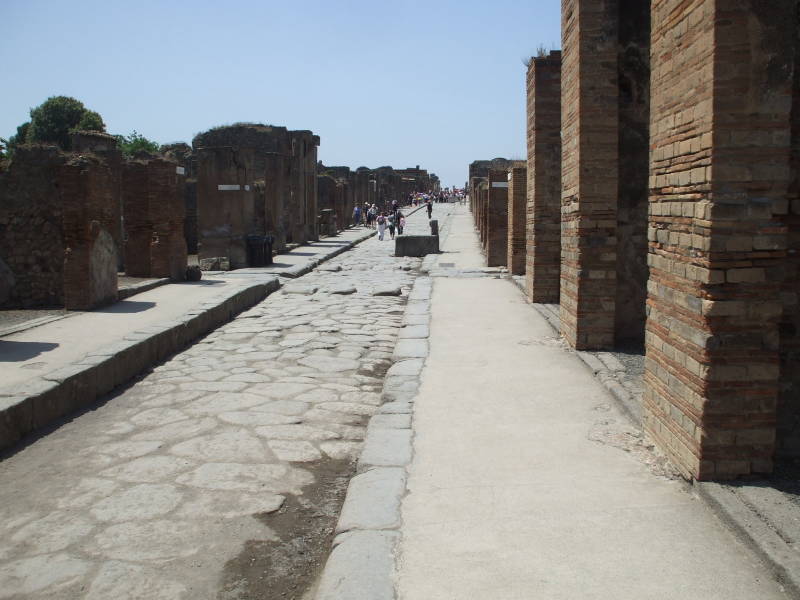
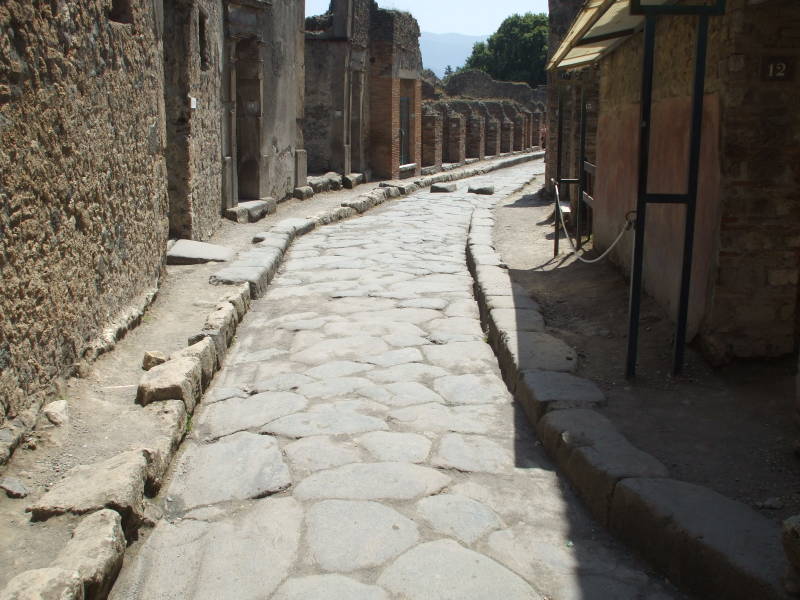
Large elevated blocks at street corners allowed people to cross the street without stepping into the waste water. And the slots between the blocks were sized and spaced to accommodate chariot and wagon axles of standard dimensions.
Fountains at Pompeii
Of course there were many public fountains in the city. Some were decorative, but most were functional sources of clean water for the residents. Here's one from the main east-west avenue. It still works, with the addition of a modern brass faucet. Refill your water bottle, there's a lot to see at Pompeii!


Above is a decorative fountain near the theatres. It hasn't been reconnected to a water supply line, at least not when I saw it. Maybe before long, though.
Baths at Pompeii
This was a Roman city, so of course there were baths. The two most prominent ones were Terme del Foro and Terme Stabiane. Those are the Italian names, as you'll find on the local maps and signs. "Forum Baths" and "Stabiane Baths", you might say.
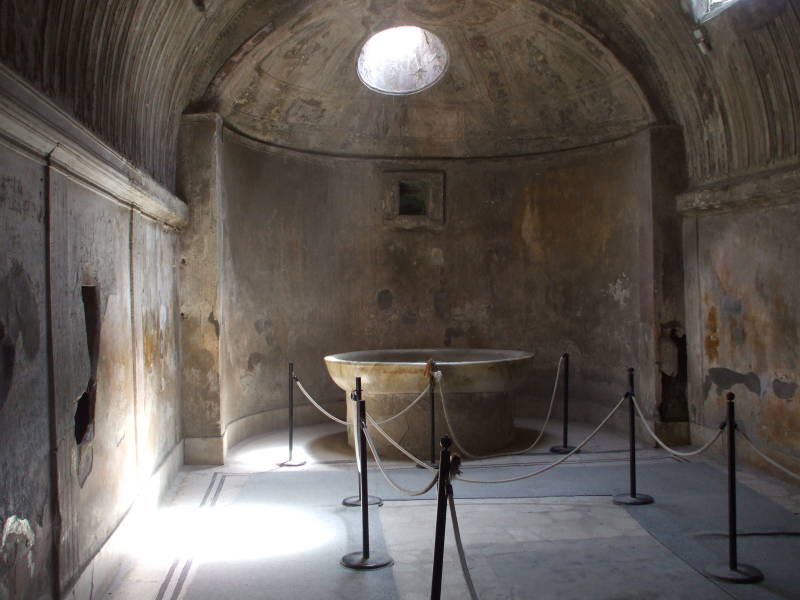
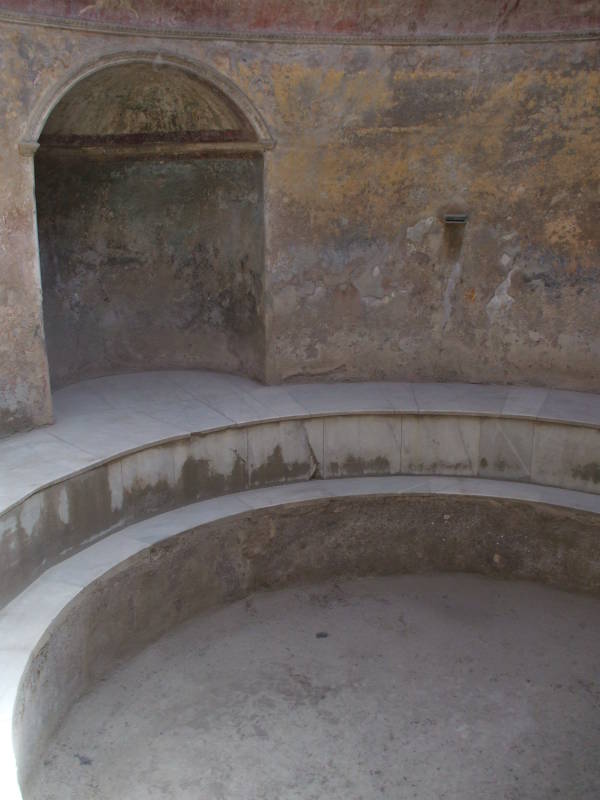
Roman baths contained the standard three chambers: frigidarium, or cold room; tepidarium, or warm room; and caldarium, or hot room.
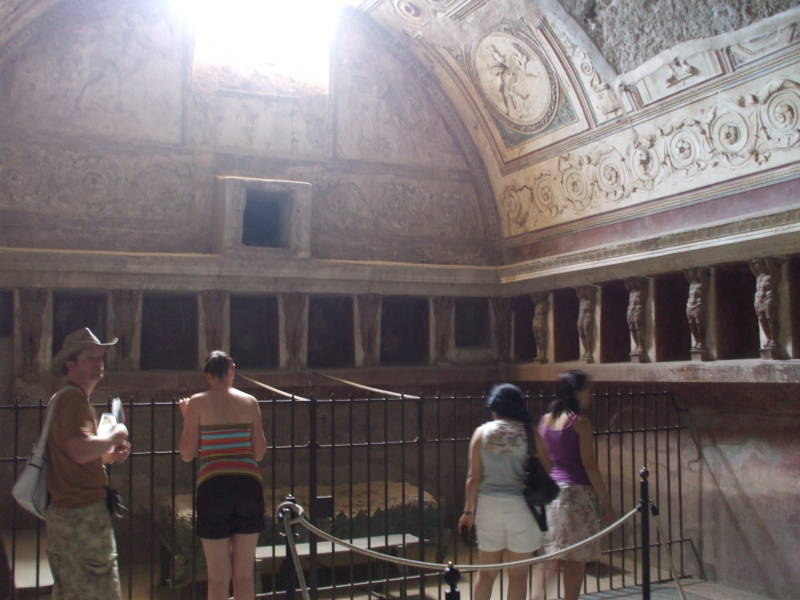
The caldarium used a hypocaust system in which hot air from furnaces was forced in the space beneath raised floors, which used stone panels or tiles held up by stacks of bricks. Here are examples from the caldarium of the Stabiane Baths.



Below are lead pipes run beneath the floor at the Stabiane Baths.


Urine-Based Wool Processing
Wool was a major product of Pompeii, including all stages of processing through the sale of finished goods.
An early wool processing step is fulling, also called tucking or walking. This is the process of cleaning or scouring to remove oils and dirt, followed by milling or thickening. These pictures show a series of tanks used for fulling wool at Pompeii. The smaller tanks are for treading and fulling, the larger ones are for rinsing.
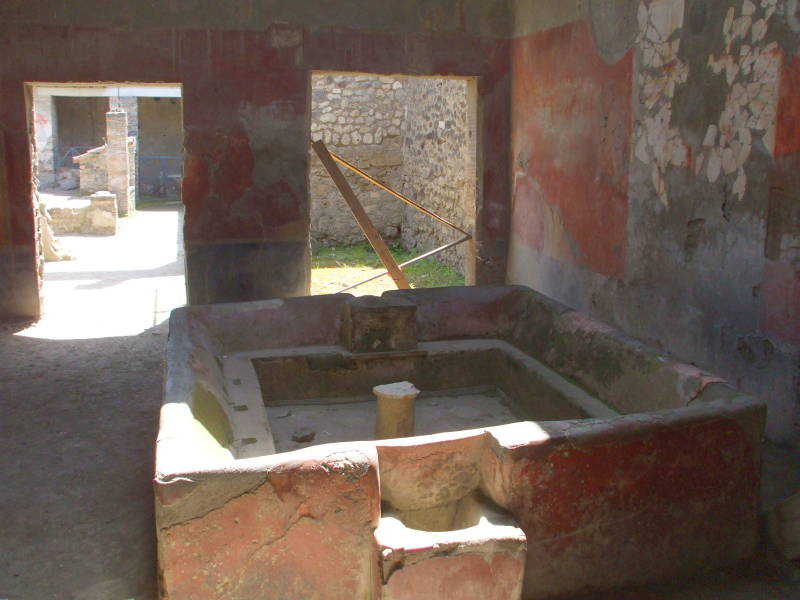
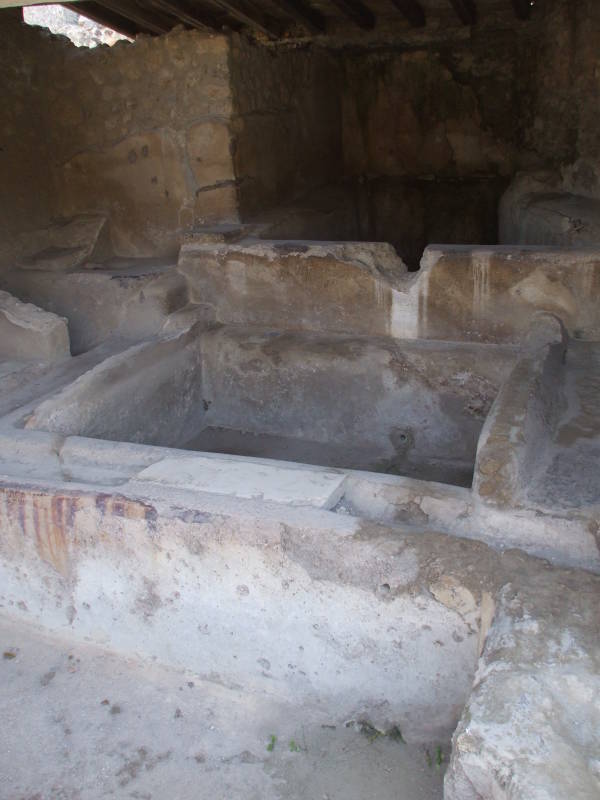

Ammonium: NH4+
The cleaning or scouring process during Roman times was based on human urine. Urine contains ammonium salts, which are components of modern soaps. Read your shampoo bottle — a handy bottle of shampoo lists ammonium lauryl sulfate, ammonium laureth sulfate, and ammonium chloride.
A wool fulling operation had to purchase the wool itself from shepherds in the surrounding countryside. But the urine needed for processing might be obtained quite cheaply or even for free.
One of the wool fulling businesses along the main street of Via dell'Abbondanza famously had a sign asking male passersby to please contribute via the jars hung on the wall. See "The Production of Woolen Cloth in the Roman World", Walter O. Moeller, 1976, page 20:
Since water was of great importance to the fullers, they had to have their establishments near sources and needed guaranteed water-rights (below, p. 96). And as with water a sure supply of urine was a prime concern. So that it might not go to waste, the fullers set out jars in the street outside their shops as a public convenience, thereby collecting some of their supply free of charge. [162] Yet since animal urine was also used, much of the substance must have been imported from the farms to the cities, and if camel urine was prized, as Pliny (HN XXVIII. 91) reports, then urine must have entered into an extensive trade pattern. Other arrangements, however, had to be made to collect the vast supply of human urine generated in the cities (below, p. 96).
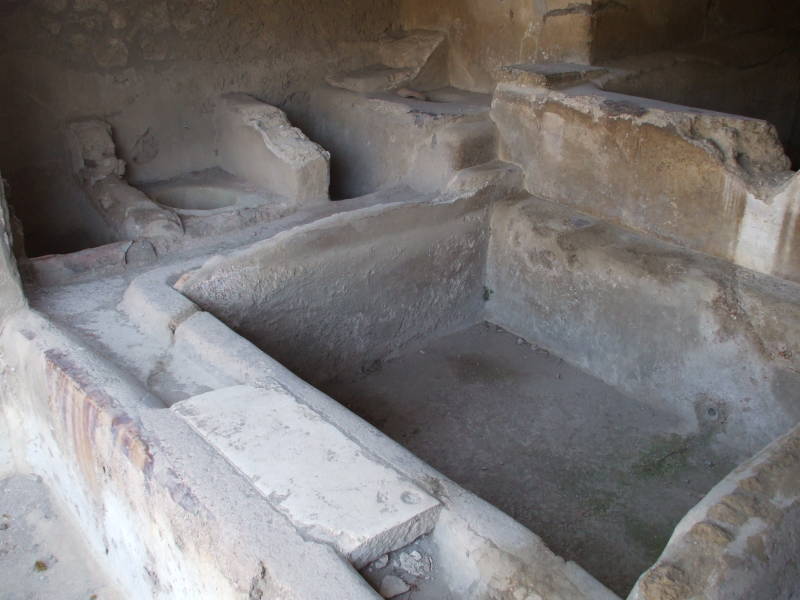
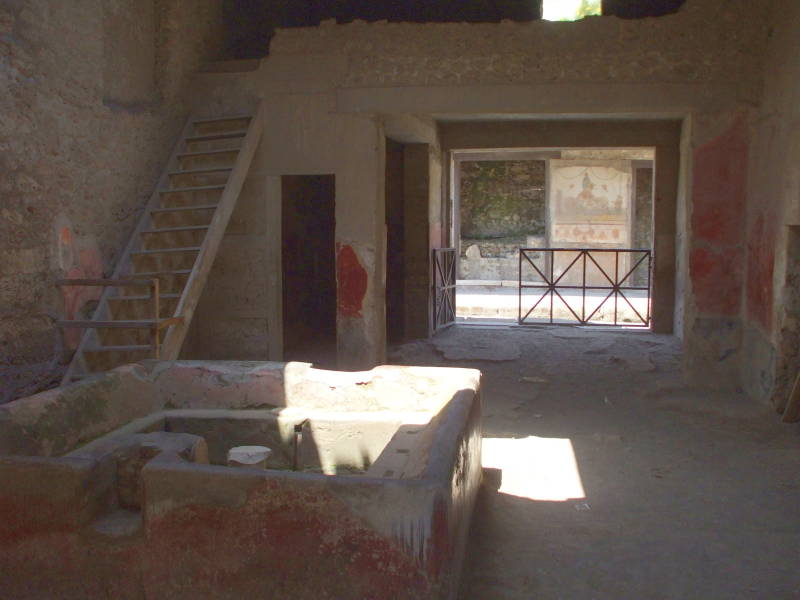
Later technology included fulling mills with arrays of water-driven broad wooden mallets to repeatedly stamp the wool immersed in its ammonium-laden bath, a mixture that combined urine with fuller's earth, a clay-like material with high magnesium oxide content. But back in Roman times, this was done by slaves stomping away in urine from ankle to knee deep.
The Birth of the English Chemical IndustryThese processes used urine for cleaning wool. Compare this to England collecting and shipping up to 200 tonnes of human urine every year starting in the 16th century to support domestic production of alum needed to dye English textiles. That happened because the Pope controlled the European alum supply, and Henry VIII had just split the Church of England off the Roman Catholic Church. The urine collection and shipping became a part of everyday English commerce, to the point that it was mentioned in Shakespeare's plays.
Modern Drainage Issues
I mentioned above that the open skylights above the impluvia were blocked off and rainwater diverted elsewhere.
Pompeii is suffering from its own modern popularity, with the site now limiting the number of visitors per day. Buy your ticket online in advance before taking the train out from Napoli. One reason is that you will avoid some very long and slow ticket purchase lines at the entrances. The other is that you will know in advance that you have a ticket to get in that day.
Large numbers of visitors exhaling and prespiring in closed spaces means moisture damage to frescos. That may be why the Lupanaro was closed to the public on my 2025 visit.
For many years it's been thought that continued burial can help to preserve some material. However, an unexcavated area is an unexcavated volume of ash and soil, and during the rainy season it accumulates a large mass of water. If it is surrounded by excavated areas, there is no support for that rectangular block of water-saturated, thus heavier and more flexible, material. It will tend to collapse outward, destroying what it contains.
The researchers and curators of Pompeii know that they need to manage groundwater, and they are working to figure out how best to remove excess groundwater. Here are some drainage pipes that I noticed just inside the entrance near the amphitheatre.

And in news of excrement measurement...
A 2011 BBC story described how a team of archaeologists working at Herculaneum had discovered a 86-meter tunnel filled with "what is believed to be the largest deposit of human excrement ever found in the Roman world." It was removed in seven hundred and fifty sacks, and studied to determine the diet of the citizens of the time.
For Today's Visitor
The site gets about 3.5 million visitors per year, its logistics are somewhat stressed. There are toilets for visitors, but they're what you should expect for an overloaded park. Functional, not fancy.

